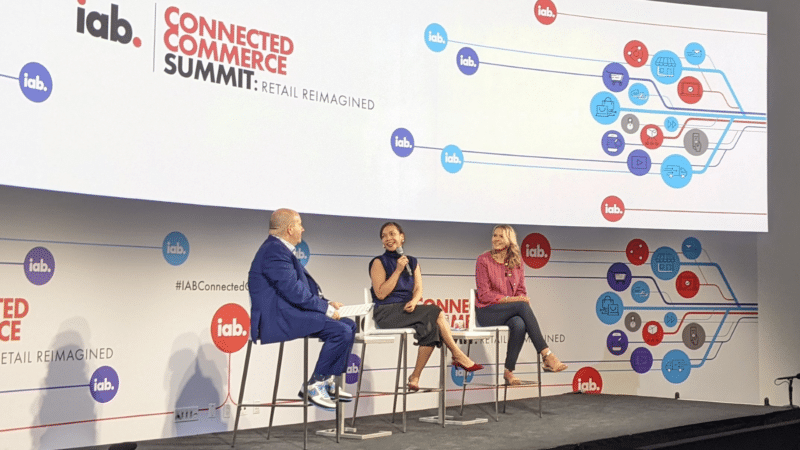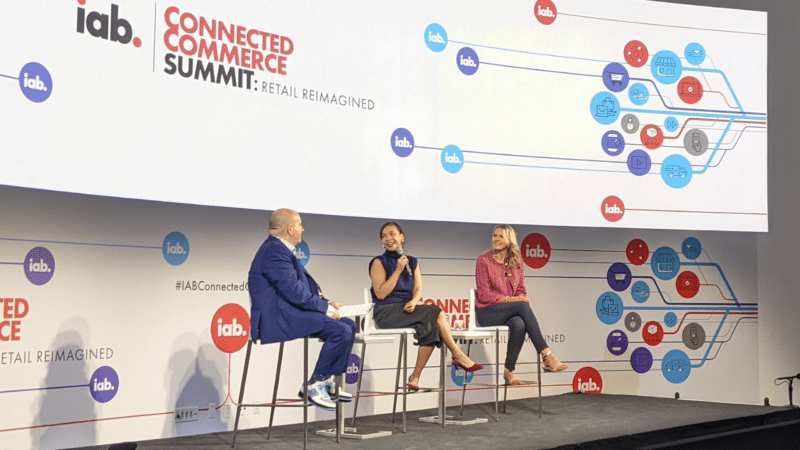

Retail media networks (RMNs) are getting new in-store definitions and standards to help reach customers where they are, and where they shop.
At IAB’s Connected Commerce Summit: Retail Reimagined in New York this week, brands, retailers and tech partners met to discuss the evolution of RMNs, an evolution that is clearly taking place.
“With the integration of advanced analytics, AI and most importantly, the importance of personalized consumer experiences, brands are increasingly leveraging these strategies at every touchpoint from initial awareness to final purchase, making retail media indispensable,” said Jeffrey Bustos, IAB’s VP, measurement addressability data, in a keynote.
IAB unveiled “In-store Retail Media Definitions and Measurement Standards,” a new tool for RMN standardization, at the summit. Last year, IAB introduced RMN guidelines in collaboration with the Media Rating Council. With a report earlier this year, IAB placed further emphasis on the opportunity for RMNs to drive sales in-store.
Dig deeper: How in-store technology will bolster retail media networks
Why we care. The potential for reaching customers through RMNs is real, which is why there’s so much interest in them. Without common standards, each network remains its own walled garden. This makes it challenging for advertisers and agencies to increase the scale and spend on multiple RMNs at one time. If they could, ad spend would likely increase much more.
In-store and omnichannel. Consumer behavior is driving both the advertiser benefits of RMN campaigns and the renewed focus of RMNs on improving in-store experience. Agencies and brands are taking note of customers’ continued interest in visiting brick-and-mortar stores and making purchases there.
These in-store experiences, however, aren’t just offline refuges — they’re part of an omnichannel journey. They are connected, through mobile and other digital channels, with the customer journey, which begins long before the customer enters the store.
Dig deeper: How brands are taking the AI plunge and testing customer experiences
“I think post-pandemic, retail is incredibly omnichannel now,” said Jacquelyn Baker, Global CEO Omnicom Commerce Group. “It was omnichannel before, but ultimately I’m surprised, coming out of pandemic — I knew expectations would accelerate, but I was surprised how much in-store experience didn’t diminish and came back. There’s stickiness to the total experience in the world we’re living in now. Consumers go from physical to digital and physical and back again. It’s interesting that the pendulum didn’t shift in one direction or the other.”
“On one hand everything has changed — consumers changed how they shop, consume content, and the type of content they consume,” said Kaisy O’Reilly, SVP, Chief Marketing Officer for shoe designer Stuart Weitzman. “Suddenly consumers spent a lot more time on their mobile phones (after the pandemic began). It’s more difficult for a brand builder…in a world of distractions and dopamine hits, especially for a luxury brand. Nothing has changed for the role of marketers. It remains important that we root ourselves in how people feel when they experience our brands.”
In this always-on omnichannel environment, It’s easier for consumers to jump in and out of the purchase funnel, so it’s important for brands to always be entertaining and helpful when they have a customer’s attention, O’Reilly explained.
Better service for advertisers. Advertisers need to be given the tools to execute successful RMN campaigns. CVS Media Exchange adopted IAB guidelines as it continues to evolve its network and in-store experiences. This year, CVS partnered with The Trade Desk to make self-service campaigning available to advertisers. CVS is also adding video screens to many of its over 9,000 U.S. locations.
“By introducing self-service, we’re empowering advertisers with the tools they need and bringing democratization to retail media,” said Melissa Gallo, head of operations for CVS Media Exchange.
Gallo added that to meet advertiser demands, CVS is working on delivering closed loop measurement and other reportings and dashboards to advertisers.
“Being able to measure and report out on retailer data has been historically held pretty close to the chest,” Gallo said. Customer health data at CVS comes with more regulations than, for instance, purchases at a grocery store, adding further restrictions to data collaborations.
Better measurement out of RMNs and across multiple RMNs will encourage brands to advertise more, especially brands that are already ramping up RMN advertising.
“I feel like for the most part we’ve really leaned into RMNs as a company,” said Pankita Desai, senior director, shopper marketing for Chobani. “We started with testing, however for us there’s a shift in the way we’re approaching RMNs and our budget. We have a really high budget from shopper marketing and less with brand marketing.”
Better reporting, especially on incrementality and effectiveness of ads, would help brand marketing make a case for spending across the full RMN ecosystem, Desai said. That’s why Chobani’s shopper marketing team, with its emphasis on low-funnel advertising, is more active in RMNs for the time being.
Risks to alienating consumers. Those advertisers delivering commerce ads to consumers might be overconfident in the effectiveness of ads, video especially. And there’s a risk in alienating customers, a study by IAB and market research consultancy Alter Agents found.
Nearly all (96%) of 300 marketers surveyed said they found commerce video ads effective at driving purchases. Meanwhile, 71% of the 1,000 consumers survey said they feel annoyed or negative toward commerce video ads on a monthly basis. And one-third said they get annoyed weekly by these ads.
Marketers need better alignment with consumer expectations when using RMNs for advertising. First, if they haven’t already, advertisers need to broaden the focus of RMN campaigns on the entire journey, not just on the low part of the funnel.
The study recommended better alignment in these areas of strategy:
- Messaging across the consumer purchase journey.
- Considerations of the consumer mood/mindset.
- Media activation, including length and frequency.
- Leveraging creator-produced content.
In-store definitions and standards. “In-store Retail Media Definitions and Measurement Standards” was released this week by IAB, in a joint initiative with IAB Europe.
The document, open for public comment until November 1, includes:
- Definitions: Clear terminology for in-store digital retail media components.
- Formats: Recommended formats for in-store advertising placements.
- Store zones: Standardized classification of key areas within stores where media can be deployed (e.g., entry, checkout, aisle).
- Measurement: Guidelines for tracking, reporting, and analyzing campaign performance across various in-store formats.
“We’re hopeful that a focus on continued dialogue and best practices creates a media ecosystem that’s transparent and sustainable for all,” said Bustos.
The post Retail media networks evolve with new in-store measurement standards and omnichannel strategies appeared first on MarTech.






